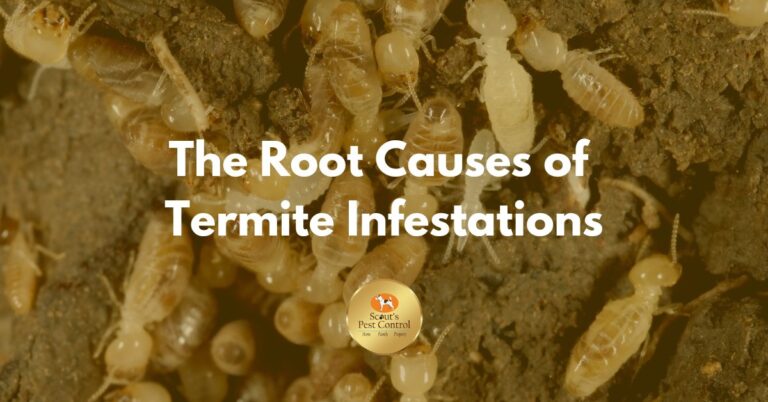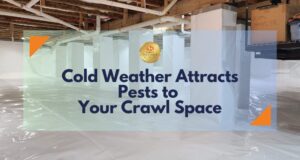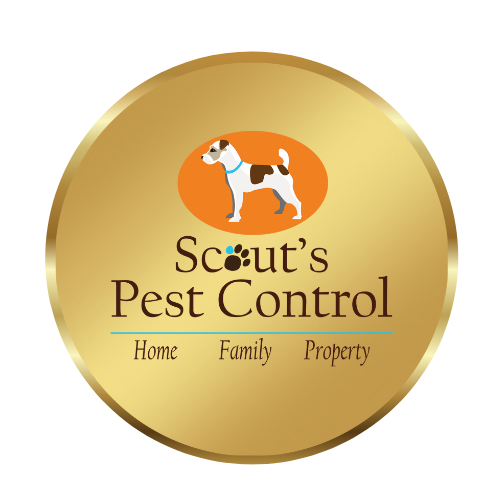In the quiet spaces of our homes or the darkness of our crawl space. There exists a pest that is silent and destructive. This pest can compromise the very foundation that supports your property, and it invades like a thief in the night. But the difference with these pests is they will remain in the vicinity. They will continue to invade 24 hours a day – 7 days a week. Termites are commonly known, yet the factors that are the root causes of termite infestations and their attraction, along with other pests, remain a mystery. These tiny pests will cause massive structural damage before a homeowner ever notices their presence.
Understanding the root causes of termite infestations is crucial in safeguarding our homes and even our businesses. Understanding why termites are attracted to a particular place or condition is the first line of defense. There has to be certain conditions and the environment must supplement the needs of the colony.
You must Understand The Enemy To Understand The Causes Of Termite Infestations
Before we can combat the enemy, we must know our enemy. Termites are not merely pests. They are a formidable force that thrives under specific environmental conditions. These conditions unfortunately align with where we build our homes in South Carolina. In fact, the conditions for their survival is perfect. Your home could be a goldmine for these wood-loving insects. Whilst there are different types of termites, which we will cover. Subterranean and drywood termites can mean the difference between early detection and costly repairs. One is more prominent than the other but both are equally as damaging.
We will dive into the world of Termites, the causes of termite infestations, and the various species that threaten us here in upstate. As a homeowner, we often only think of one species as being problematical, but in truth there are more. Moreover, it is important to also identify the environmental factors that invite these pests into our homes. We will also offer valuable insights into their complex social structure and nesting habits. Knowledge is power and this is your first line of defense. To understand the Termite attractor factor.

Understanding Termites: An Intellectual View
Termites are silent destroyers, and have a reputation for destroying wooden structures. These wooden structures are not just structures that bear the weight of your home, but can involve a myriad of potential structures as you will deduce further. They are particularly drawn to damp environments where cellulose, their primary food source, is abundant. A single colony burrowing into foundations can lead to severe structural damage. This damage can occur from right under your nose. Before you know it, you have a severe infestation that will cause you a tremendous amount of money to rectify. It is better to be pro-active than reactive. More about that later.
What Is Cellulose And Why Is It One Of The Root causes Of Termite Infestations?
Like all living creatures, we need certain things to survive: food, shelter and water. Now termites are no different and one of the most important sources of sustenance is of course cellulose, which is abundant in wooden structures and oftentimes products we utilize around the home.
Cellulose is a complex carbohydrate or polysaccharide, consisting of 3000 or more glucose units. So in essence, it is a sugary type substance. It is used in a variety of products such as food products, paper, containers and of course in wood. Why? Because it is a plant-based material that is abundant in nature. Cellulose is a polymer fiber that is the primary strengthening source within wood. Therefore, it is abundant in constructed property here in the south and that is one of the main attractants to termites. They feed on cellulose material.
Cellulose and Termite Damage
In the United States, termite damage is estimated to cost $5 billion in damages each year, and it's down to the conducive environment and the abundance of cellulose material. Therefore, a homeowner needs to understand the nesting behavior, and the causes of termite infestations. You need to understand what is at the root of a potential infestation. There’s also a myth about Termites. Many people wrongly think that termites live in wood. Predominantly, the ones we are concerned about in South Carolina nest underground or nest in other wooden structures. More about that later.
If you are a homeowner, you need to be vigilant of untreated wood around your property. Untreated wood will serve as a magnet for termite infestations because of the food source it offers. Environments conducive to termite activity can be identified by regular termite inspections and preventative measures to avoid the costly consequences of their presence.
Types of Termites In South Carolina
Termites come in various species, each with its own preferences for climate and wood types. This makes them adaptable to different environments. The most prominent here in South Carolina are subterranean termites, and drywood termites. There are also dampwood termites, and invasive Formosan termites in the US. However, we will only be concentrating on the species that cause most concern here in the south.
As a consequence, it is imperative to understand the characteristics and behavior of each species. This is critical for property owners as the knowledge is not only useful for treatment but also vital for taking precise preventative steps to protect your home or business from Termite invaders.
Subterranean termites are the most prevalent in the United States. In fact, the eastern subterranean termite is the one that we deal with most in the upsate. They form colonies underground and are notorious for constructing mud tubes that grant them safe passage to above-ground food sources. Drywood termites are less common in the south, but they do exist, and you may know them under a different guise.
These species of Termites are found in climates such as we have here in the South. They nest inside dry wood such as furniture and building structures. They require no soil contact, unlike subterranean termites, to sustain their lifestyle, and can be just as damaging in a home. More about that species below.
Recognizing the signs of each type, from the mud tubes left behind by subterranean termites to the discarded wings from drywood termite swarmers, can allow for timely intervention to thwart their destructive potential.
Subterranean Termites are the most prevalent
Subterranean termites thrive in moist environments, often building intricate colonies beneath the ground. They are moisture-dependent and construct mud tubes, which are tunnel-like structures made from soil and termite secretions, to travel safely and undetected from their soil habitat to food sources. These termites forage for wood and other cellulose materials, and evidence of their presence includes the sightings of mud tubes on exterior walls, the discovery of damaged wood that sounds hollow when tapped, and the occasional presence of swarmers or their discarded wings. It is crucial to be alert for these signs, as subterranean termite activity can quickly lead to severe structural damage if not promptly addressed.
Drywood Termites
Conversely, Drywood termites have adapted to live with much less moisture and are found within the wooden elements they infest. According to Clemson University, the species that we have here are known as the powderpost beetle or furniture termite, the Southeastern drywood termite, and one named Kalotermes approximatus, which does not have a simplified name attached to it, and is quite rare in the state. However, it has been found in 18 areas within the state of South Carolina. It is quite obvious the climate and environment is perfect for the survival of these Termite species.
As we mentioned previously, it is important to know that these pests do not need contact with the soil. They will infest attic beams, subfloors, and furniture. While their colonies may grow slower than those of subterranean termites, they can still expand significantly, with some colonies housing over a million termites.
Signs Of Drywood Termites
These termite colonies are difficult to detect due to their secretive behavior. You can identify drywood termite activity by the following signs. The presence of fecal matter known as frass. You will notice subtle blisters in wood flooring, entry holes and even noise from the termites within the wood.
- Frass: This is the droppings of the termites and are pelleted like. You will notice this around the structure almost sawdust like at first glance.
- Blisters In Wooden Floors: This is easy to recognize due to the change in the structure and the discoloration of the wood. It also looks like it has a raised bubbling effect.
- Entry holes: You may notice tiny entry holes in the wood such as exemplified in the image below.
- Noises: You can hear feint clicking sounds coming from the walls or the furniture. This is almost reminiscent of a metal ball desk pendulum that clicks on each swing or the click of a dog training device.

Entry points for these termites include cracks in wood siding, eaves, and around windows and doors, emphasizing the need for regular visual inspections of these areas to prevent infestations.
The Termite Colony and Behavior
Now let’s look at some of the particular behaviors of these termites. When you understand termite behavior, it becomes easier to make the right judgment on what to do about them.

Termites form highly complex and organized colonies that are very quick to expand. The size of colonies varies dramatically, from a mere few thousand to over one million if the right conditions exist for survival.
Drywood termites, known for living in drier conditions, can lay around 10 eggs daily, and the colonies can also expand to more than 1 million termites in active periods. Their reproduction is a slow process, often occurring through a process called 'budding' or division from the original colony, a method particularly employed by dampwood termites. Subterranean Termites can expand very quickly and will swarm when the conditions are right. This is when the alates Termites swarm when the colony has reached a certain capacity. This is another behavior of the Termites that is crucial for survival and expansion of the species.
Termite Social Structure
The social construct within a colony is well-defined, consisting primarily of worker termites, soldier termites, and a termite queen, each playing a critical role in the colony's survival. Worker termites, the largest group, are responsible for foraging, feeding, and taking care of the colony.
Soldier termites protect the nest from threats, and the queen's role is to reproduce continuously, ensuring the colony's growth. Treatment of termite infestations is very complex and requires the knowledge of a termite specialist. A termite infestation requires advanced control methods employed by pest control professionals to effectively eradicate a colony.
As we mentioned previously, as part of their natural behavior, termites can swarm during the warmer months to disperse and establish new nests which is critical for their survival and the propagation of the species.
Termite Nesting Habits
We have mentioned this before, but now dive a bit deeper into the nesting preferences of termites. Of course the needs are aligned with the conducive survival conditions, which are warm, dark, and secluded environments. The foundations of homes are particularly attractive to these pests due to the dark, moist conditions often found there, especially in crawl spaces.

Termites gain entry through gaps or cracks in the foundation or the exteriors of homes. They burrow into the ground or wood and develop systems of tunnels and protective mud tubes for transport. These structures help to facilitate movement within the colony and help termites to avoid exposure to open air and predators.
Environmental Conditions That Attract Termites
Conditions that encourage termite activity are linked to moisture and humidity. As an example, subterranean termites, among the most widespread termite species, prefer moist soil and are commonly found in sandy or loamy terrain with efficient drainage. When termites venture above ground, they seek the same dampness they enjoy underground.
They are particularly drawn to regions where temperatures typically remain above 70°F. This ensures rapid growth and expansion of their colonies.
Leaky pipes, improper drainage, or simply high indoor humidity levels can act as an open invitation to termites. To prevent termite attraction to homes, it is vital to eliminate sources of moisture by ensuring good airflow, rectifying any leakages, and removing any wood-to-soil contact points. Furthermore, if you have a crawl space, you should ensure you have the space encapsulated and treated for potential termite infestations.
Improper Ventilation and Drainage
Poor drainage can lead to pooled water, which will compromise the home's foundation. This sets the stage for a termite infestation. Furthermore, poor ventilation can contribute to the development of high humidity levels, and thus offer the perfect conducive conditions for Termites to thrive. As a side note, you will also find that your energy costs increase with high humidity, which is another reason to take action.
It is crucial for homeowners to ensure that the soil around the building slopes away from the foundations, helping to prevent standing water. Additionally, areas like attics and basements need to be properly ventilated to keep air circulating and humidity levels down. If you do not have a crawl space dehumidifier or a French drain installed, and you have a moisture issue, this is something you should rectify immediately.
Water-Damaged Wood and Leaky Pipes
Wood damaged by water is like a magnet for termites. Such wood, softened and rich in moisture, provides not only an easy meal but also a potential nesting site. Leaky pipes, a common issue in many homes, can exacerbate this problem by causing additional moisture damage. Clogged gutters or malfunctioning AC units are further contributors to undesirable situations which can ultimately attract termites to an otherwise unwelcoming home.

Preventative strategies are key in these instances. It is vital to maintain and repair plumbing and HVAC systems regularly to prevent them from becoming sources of moisture that could entice termites. Additionally, good ventilation, exposure to sunlight, and proper drainage around and under the home can alleviate conditions conducive to termite infestations.
Electrical Conduits and Direct Contact
When you are building your home or renovating a home, you will often make changes or even install new electrical and plumbing systems. However, oftentimes as a house settles or shifts, there could be potential cracks and openings that will form due to the movement and settling of the structure. This offers an easy entrance point by termites and, of course, other pests.
To mitigate the risk, it is crucial to monitor and seal areas where electrical conduits and plumbing emerge from the ground or foundations, especially if there is direct wood-to-soil contact.
The Role of Food Source in Termite Infestations
The presence of a food source is a critical factor in understanding the root causes of termite infestations. Ensuring that materials containing cellulose such as wood stacks, paper goods, and cardboard are managed properly is key to reducing the risk of infestation.
Considerations for Preventing Termite Infestations:
- Wood Piles: Keep firewood away from the home's foundation and elevate it to prevent direct contact with the ground.
- Mulch In Flower Beds: Mulch, when used in your garden, does have an aesthetic element to it, but it can also be an attractant for Termites. If you must use Mulch, ensure it is away from the foundation of your home.
- Cellulose Materials: Store paper, cardboard, and similar materials in sealed containers away from walls and crawl spaces.
- Leaky Plumbing: Address any leaky pipes or improper drainage to eliminate excess moisture that termites find appealing.
- Regular Inspections: Perform regular inspections of the home to identify and rectify conditions that might attract termites, such as water-damaged wood.
By minimizing the availability of cellulose materials and controlling moisture levels, homeowners can create an environment less hospitable to termite colonies, thereby reducing the chance of termites turning their property into a food source.

Regular Inspections and Professional Services
One of the biggest problems with understanding the causes of termite infestations is a lack of knowledge for homeowners. Even though you may understand the theory. Practice is often a very different thing and experience trumps theory every time. This is why you need the skills of a professional pest control company and their Termite experts.
To begin with, routine inspections of your foundation, roof, and plumbing systems are your front line against termites—it – it allows you to catch problems before they turn into infestations. Moisture is a termite's ally, so identifying and addressing any sources of dampness is vital in this prevention strategy. It is not easy to identify termite problems. This is why Scouts Pest Control have the expertise and the knowledge to identify problems that you will often miss. We will be able to recognize signs that are in areas you would not think would be problematic, and we have seen every potential threat and sign you can imagine.
It's therefore advisable to engage in professional termite inspections annually. Our experts are trained to detect early signs of termite presence. This preemptive step can save your home from severe structural damage by intercepting termite colonies before they become an overwhelming force. Moreover, a pest control maintenance plan heightens a household’s defenses, offering peace of mind that professional support is continually at hand.





